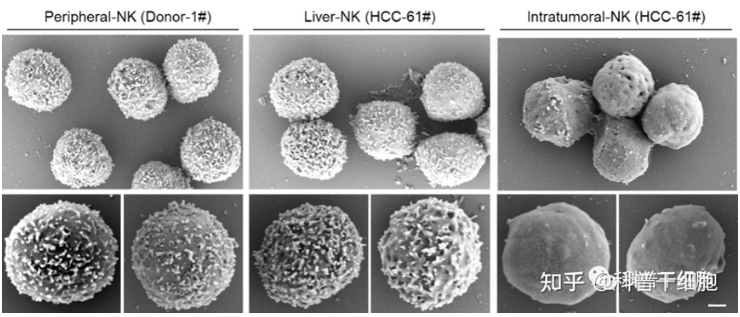Natural killer cells (NK cells) are the "professional killers" of tumors and play an important role in anti-tumor immunotherapy. However, in the tumor microenvironment, the anti-tumor function of NK cells is seriously challenged, and most advanced tumors can escape the killing of NK cells, so it is urgent to understand the mechanism. Search for a new scheme to restore NK cell function.
It was found that NK cells in the tumor tissue microenvironment lost the surface membrane protrusions, could not recognize tumor cells, and lost the anti-tumor function. The research results are published on March 23, 2023: Tumors evade immune cytotoxicity by altering the surface topology of NK cells was published in the journal Nature Immunology, This study reveals a new mechanism of tumor immune escape, and provides a new idea and a new target for tumor immunotherapy based on NK cells.

In this study, transmission and scanning electron microscopy techniques were used to clearly see obvious differences in the topological morphology of NK cell membranes in the microenvironment of normal tissues and tumor tissues. There were abundant protrusions on the surface of normal NK cell membranes, while the surface of NK cell membranes in the microenvironment of tumor tissues was abnormally smooth and the protrusions were obviously lost (FIG. 1). Figure 1: The surface of normal NK cells derived from peripheral blood and liver tissue showed abundant membrane protrusions (left and middle), while the surface of NK cells in the tumor microenvironment was abnormally smooth and the membrane protrusions were lost (right). Further exploration found that normal NK cells use membrane processes to recognize and grasp tumor cells, and promote cell-cell interactions to form "immune synapses" and play a tumor-killing role. This kind of immune synapse is a special intercellular structure formed between NK cells and tumor cells, and NK cells release granase to dissolve and kill tumor cells through immune synapse. However, in patients with advanced tumors, the tumor tissue microenvironment NK cell processes are lost, unable to recognize tumor cells, unable to form immune synapses, and thus lose the ability to kill tumor cells (Figure 2).

Figure 2: Normal NK cells from peripheral blood and liver tissue use membrane processes to form "immune synapses" with tumor cells (left and center), while NK cells from the tumor tissue microenvironment lack membrane processes and fail to form (right). The membrane composition of NK cells in the tumor microenvironment was changed, mainly because the content of sphingomyelin was significantly reduced, and it was confirmed that the dysregulation of serine metabolism in the tumor microenvironment was the main cause of the decline of sphingomyelin. The use of inhibitors targeting sphingomyelin can significantly increase the sphingomyelin content of NK cell membrane in tumor microenvironment, restore process formation, and improve tumor cell recognition and killing ability. Intervention targeting sphingomyelin enzyme combined with immune checkpoint blockers has a synergistic anticancer effect. This study explains the new mechanism of tumor-derived NK cell dysfunction and immune escape from the perspective of novel cell membrane topology, and also provides a new strategy for improving the immunotherapy of NK cells.
